 EXTERNAL ENVIRONMENT
Matthew Marsh
24 September 2014
Exhibit 99.1 |
 EXTERNAL ENVIRONMENT
Matthew Marsh
24 September 2014
Exhibit 99.1 |
  DISCLAIMER
2
This Management Presentation contains forward-looking statements. James Hardie may from time to
time make forward-looking statements in its periodic reports filed with or furnished to the
SEC, on Forms 20-F and 6-K, in its annual reports to shareholders, in offering circulars, invitation memoranda and prospectuses, in media releases and
other written materials and in oral statements made by the company’s officers, directors or
employees to analysts, institutional investors, existing and potential lenders, representatives
of the media and others. Statements that are not historical facts are forward-looking statements and such forward-looking statements are statements made
pursuant to the Safe Harbor Provisions of the Private Securities Litigation Reform Act of 1995. Examples of forward-looking statements include: •
statements about the company’s future performance; •
projections of the company’s results of operations or financial condition; •
statements regarding the company’s plans, objectives or goals, including those relating to
strategies, initiatives, competition, acquisitions, dispositions and/or its products; •
expectations concerning the costs associated with the suspension or closure of operations at any of
the company’s plants and future plans with respect to any such plants; •
expectations concerning the costs associated with the significant capital expenditure projects at any
of the company’s plants and future plans with respect to any such projects; •
expectations regarding the extension or renewal of the company’s credit facilities including
changes to terms, covenants or ratios;
•
expectations concerning dividend payments and share buy-backs; •
statements concerning the company’s corporate and tax domiciles and structures and potential
changes to them, including potential tax charges;
•
statements regarding tax liabilities and related audits, reviews and proceedings; •
statements regarding the possible consequences and/or potential outcome of the legal proceedings
brought against two of the company’s subsidiaries by the New Zealand Ministry of Education
and the potential product liabilities, if any, associated with such proceedings;
•
expectations about the timing and amount of contributions to Asbestos Injuries Compensation Fund
(AICF), a special purpose fund for the compensation of proven Australian asbestos-related
personal injury and death claims;
•
expectations concerning indemnification obligations; •
expectations concerning the adequacy of the company’s warranty provisions and estimates for
future warranty-related costs;
•
statements regarding the company’s ability to manage legal and regulatory matters (including but
not limited to product liability, environmental, intellectual property and competition law
matters) and to resolve any such pending legal and regulatory matters within current estimates and in anticipation of certain
third-party recoveries; and
•
statements about economic conditions, such as changes in the US economic or housing recovery or
changes in the market conditions in the Asia Pacific region, the levels of new home
construction and home renovations, unemployment levels, changes in consumer income, changes or stability in housing
values, the availability of mortgages and other financing, mortgage and other interest rates, housing
affordability and supply, the levels of foreclosures and home resales, currency exchange rates,
and builder and consumer confidence. |
  3
Words such as “believe,” “anticipate,” “plan,” “expect,”
“intend,” “target,” “estimate,” “project,” “predict,” “forecast,” “guideline,” “aim,” “will,” “should,” “likely,” “continue,”
“may,” “objective,” “outlook” and similar expressions are intended
to identify forward-looking statements but are not the exclusive means of identifying such statements. Readers
are cautioned not to place undue reliance on these forward-looking statements and all such
forward-looking statements are qualified in their entirety by reference to the following
cautionary statements.
Forward-looking statements are based on the company’s current expectations, estimates and
assumptions and because forward-looking statements address future results, events and
conditions, they, by their very nature, involve inherent risks and uncertainties, many of which are unforeseeable and beyond the company’s control. Such known
and unknown risks, uncertainties and other factors may cause actual results, performance or other
achievements to differ materially from the anticipated results, performance or achievements
expressed, projected or implied by these forward-looking statements. These factors, some of which are discussed under “Risk Factors” in
Section 3 of the Form 20-F filed with the Securities and Exchange Commission on 26 June 2014,
include, but are not limited to: all matters relating to or arising out of the prior
manufacture of products that contained asbestos by current and former James Hardie subsidiaries; required contributions to AICF, any shortfall in AICF and the effect
of currency exchange rate movements on the amount recorded in the company’s financial statements
as an asbestos liability; governmental loan facility to AICF; compliance with and changes in tax
laws and treatments; competition and product pricing in the markets in which the company operates; the consequences of product failures or
defects; exposure to environmental, asbestos, putative consumer class action or other legal
proceedings; general economic and market conditions; the supply and cost of raw materials;
possible increases in competition and the potential that competitors could copy the company’s products; reliance on a small number of customers; a
customer’s inability to pay; compliance with and changes in environmental and health and safety
laws; risks of conducting business internationally; compliance with and changes in laws and
regulations; the effect of the transfer of the company’s corporate domicile from The Netherlands to Ireland, including changes in corporate governance
and any potential tax benefits related thereto; currency exchange risks; dependence on customer
preference and the concentration of the company’s customer base on large format retail
customers, distributors and dealers; dependence on residential and commercial construction markets; the effect of adverse changes in climate or weather
patterns; possible inability to renew credit facilities on terms favourable to the company, or at all;
acquisition or sale of businesses and business segments; changes in the company’s key
management personnel; inherent limitations on internal controls; use of accounting estimates; and all other risks identified in the company’s reports filed with
Australian, Irish and US securities agencies and exchanges (as appropriate). The company cautions you
that the foregoing list of factors is not exhaustive and that other risks and uncertainties may
cause actual results to differ materially from those referenced in the company’s forward-looking statements. Forward-looking statements speak
only as of the date they are made and are statements of the company’s current expectations
concerning future results, events and conditions. The company assumes no obligation to update
any forward-looking statements or information except as required by law. |
  AGENDA
•
U.S. Economic Indicators
•
Housing Market Overview
•
Market Opportunity for James Hardie
4 |
  U.S.
ECONOMIC INDICTORS IMPROVING 5 |
 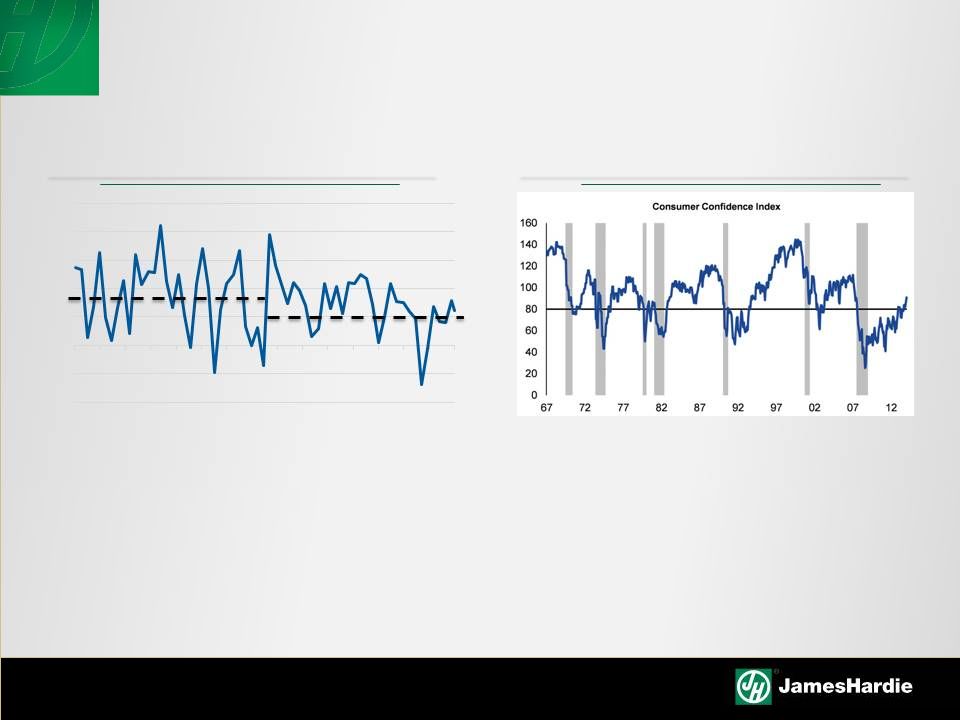 GDP AND
CONSUMER CONFIDENCE Source: Conference Board, Morgan Stanley Research.
Note: Gray shading denotes period of recession as determined by the
NBER Source: Bureau of Economic Analysis, Morgan Stanley Research.
Note:
Gray
shading
denotes
periods
of
recession
as
determined
by
the
NBER
•
U.S. in recovery from global financial crisis …
GDP growing albeit at modest levels
•
After plummeting to a historic low of 25.3 in February 2009, consumer confidence
surpassed 80 in March 2014. A level around 80 has been the average
measure of confidence during past recoveries
U.S. GDP
Consumer Confidence
6
-4%
-2%
0%
2%
4%
6%
8%
10%
51
56
60
64
68
72
76
81
85
89
93
97
01
06
10
14 |
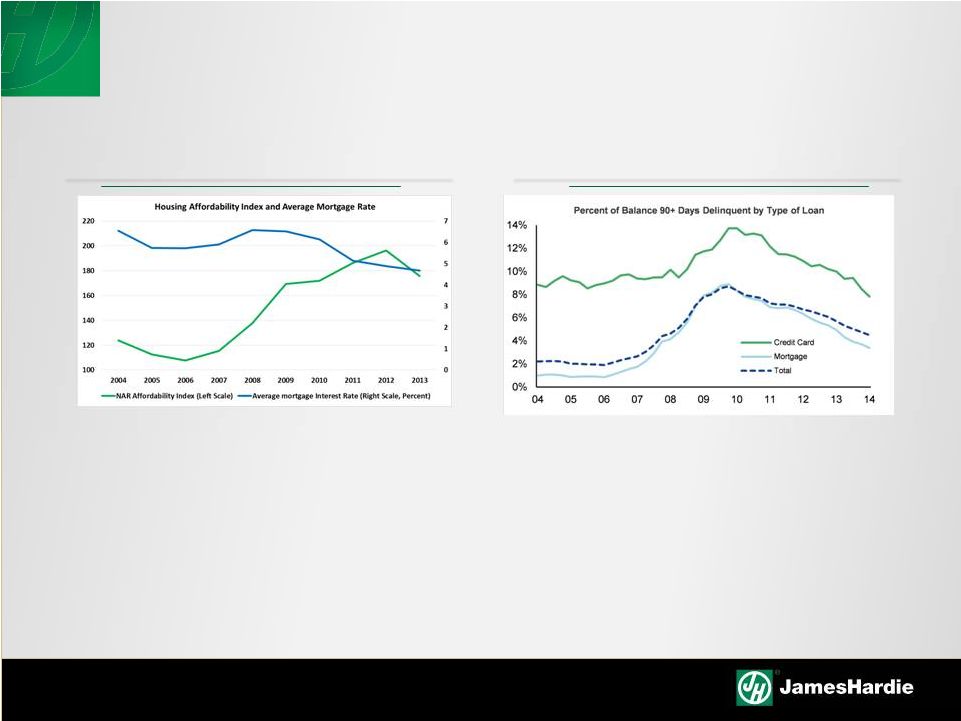 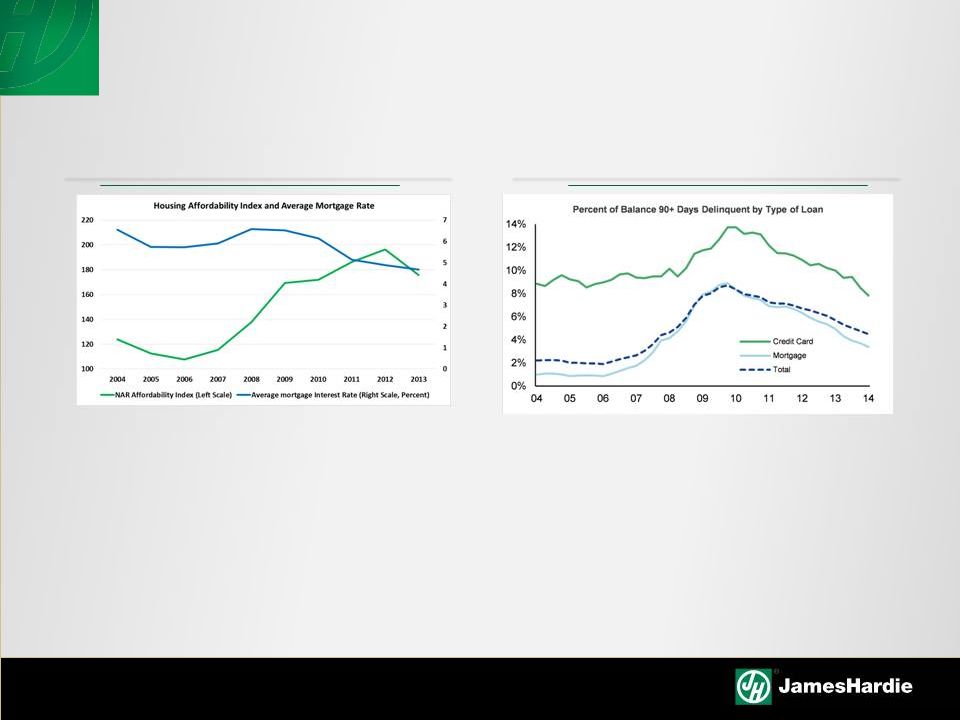 US
CONSUMER CREDIT IS STRENGTHENING Source: Federal Reserve Board, Morgan
Stanley Research. Note: The financial obligations ratio (FO R) includes auto lease payments,
consumer
debt
payments,
rental
payments
on
tenant-occupied
property,
payments
on
mortgage
debt,
homeowners’
insurance
and
property
tax payments.
•
Ownership affordability drivers are becoming more favorable
•
Mortgage interest rates remain at historical lows
•
Household leverage is sustainable, and credit conditions and
lower delinquency rates indicate the cycle peak in not near
Home Affordability & Interest Rates
90+ Day Delinquencies
Sources: JCHS Tabulations of Freddie Mac. Primary Mortgage Market
Survey; National Association of Realtors®, Housing Affordability Index
7 |
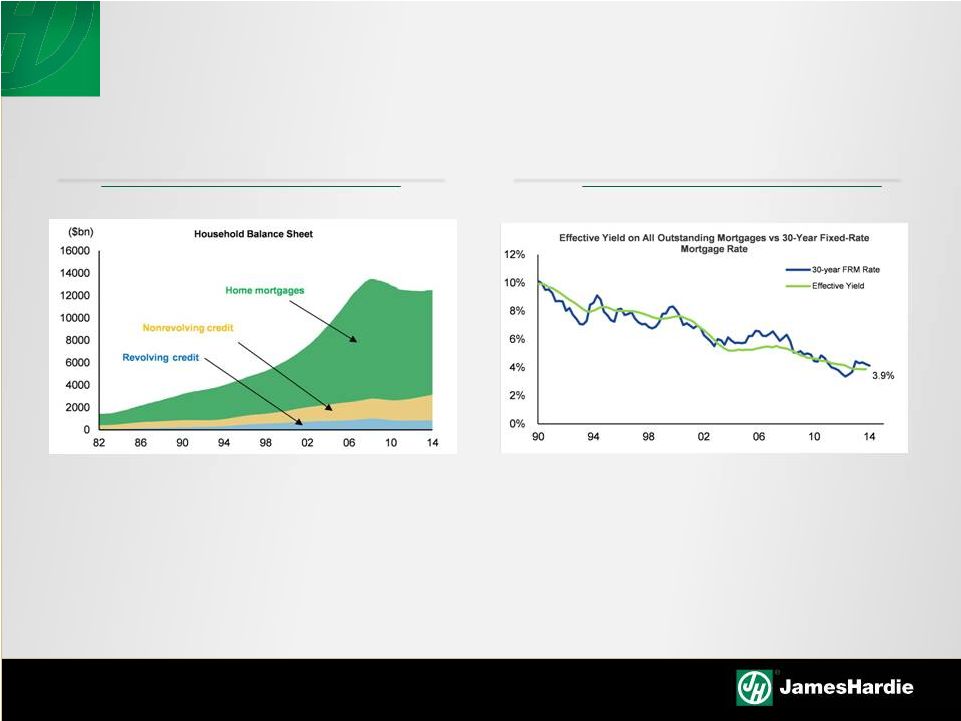 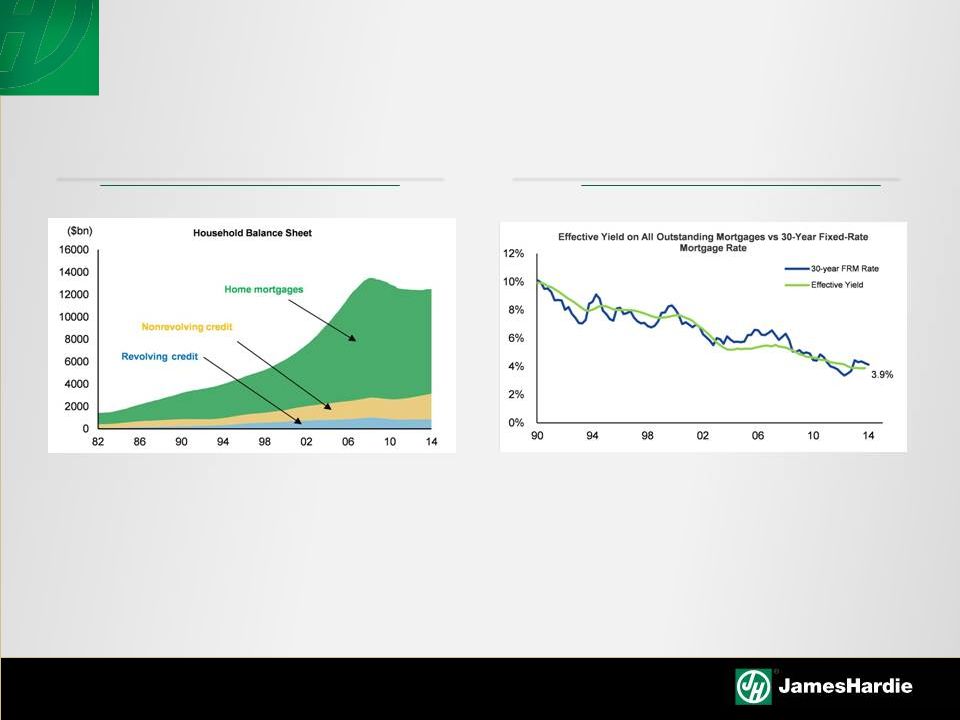 US
CONSUMER BALANCE SHEETS ARE HEALTHIER Source: Bureau of Economic
Analysis Source: US Federal Reserve
•
Roughly 75% of the household balance sheet is in mortgages…
•
…
and
30-year
fixed-rate
mortgage
rate
at
historical
lows
–
meaning
the
bulk
of
average household’s balance sheet is locked in at an extremely low fixed
rate •
This should help US households remain nimble as market conditions tighten
Household Balance Sheet
Yield on All Mortgages vs. 30-Year Fixed
8 |
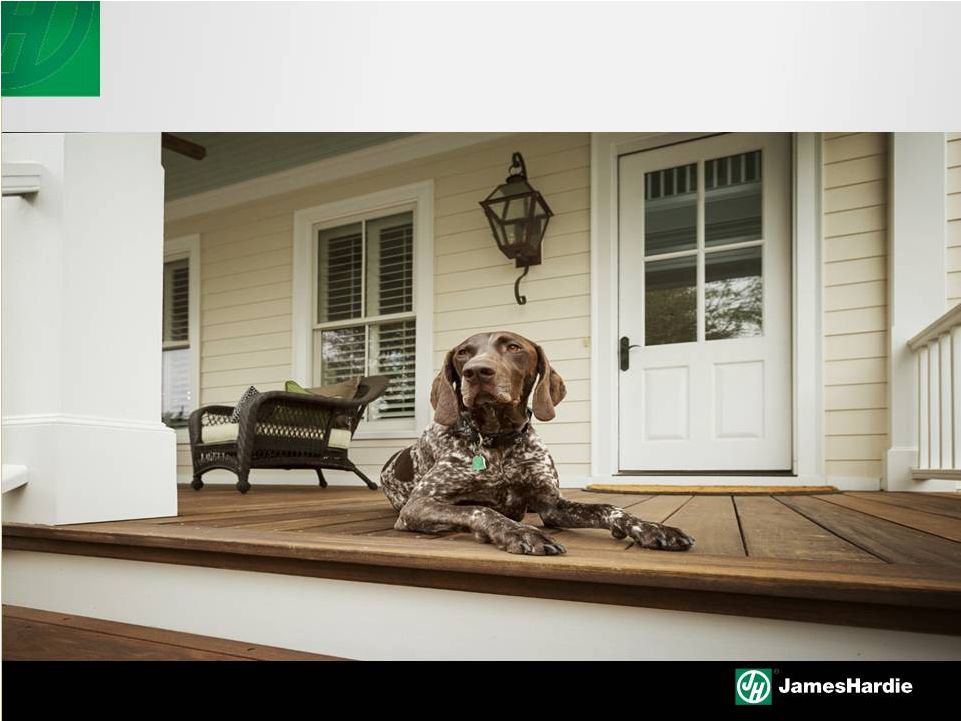 HOUSING MARKET OVERVIEW
9 |
  HOME
PRICES AND INVENTORIES Home prices have stabilized and are
beginning to rise slowly…
…while inventories of new and existing
homes are near historic lows
Source: National Association of Realtors
Source: McGraw Hill Financial
Existing & New Home Inventories
S&P/Case-Schiller U.S. National Home Price Index
10 |
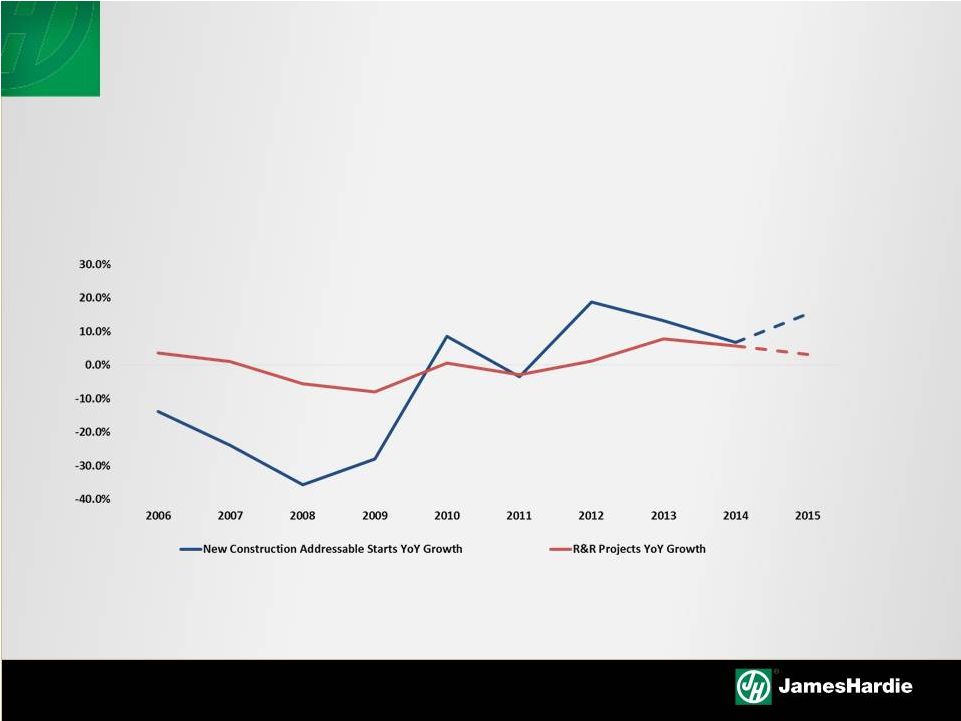 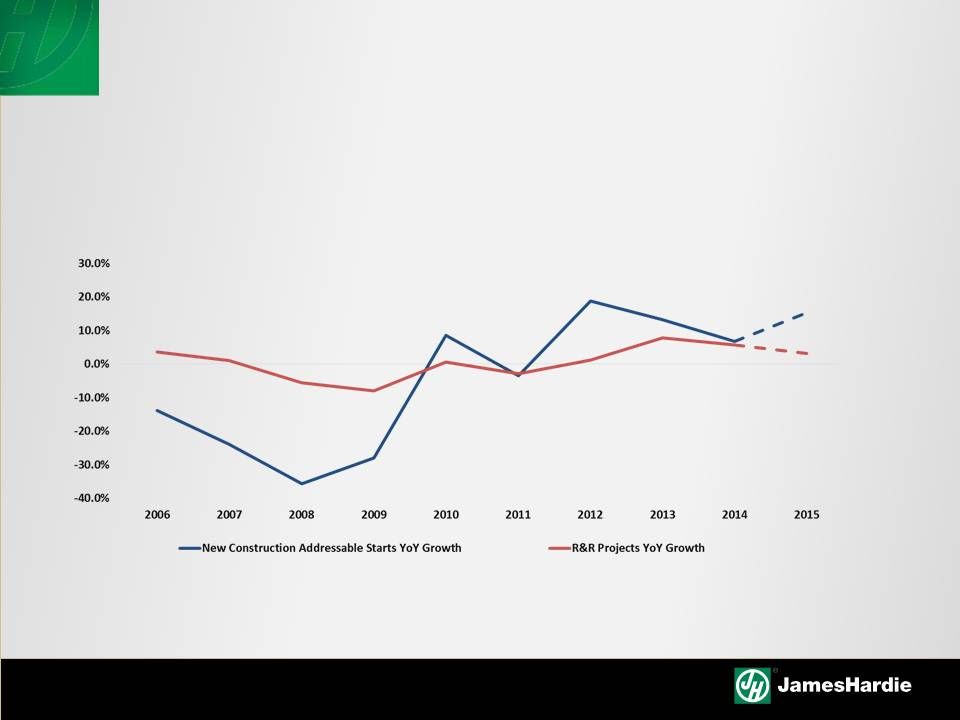 INDICATORS SUGGEST MARKET IS IN RECOVERY
Single-family new construction and multifamily starts growing
at a faster rate than the repair and remodel segment
Sources: Dodge New Construction Forecast and James Hardie Internal Management
Estimates 11 |
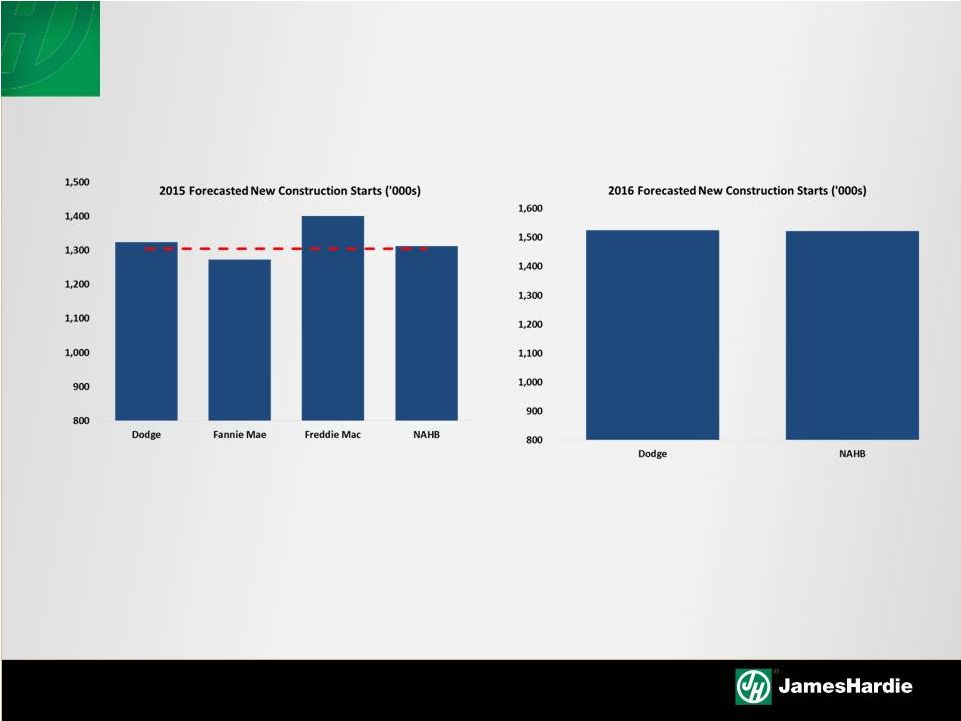 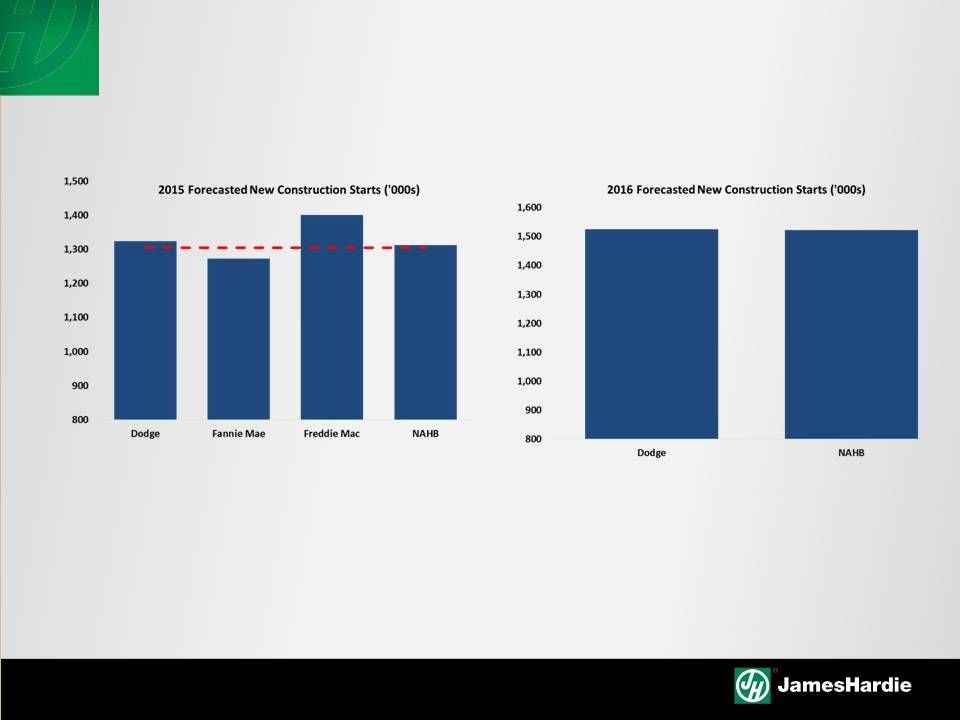 NEW
CONSTRUCTION STARTS HEADING BACK TOWARDS ~1.5 MILLION STARTS PER YEAR
•
Variation in forecasting starts between different organization exists
•
New starts growth forecast 2015 range: 20% and 33%
•
New starts growth forecast for 2016 range: 15% and 16%
12 |
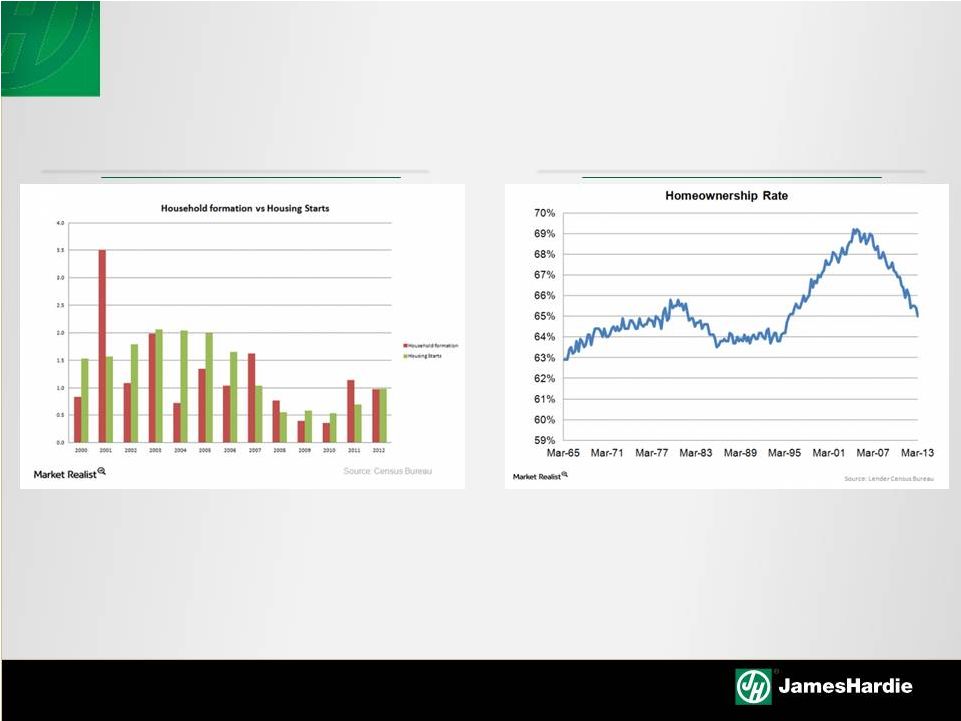 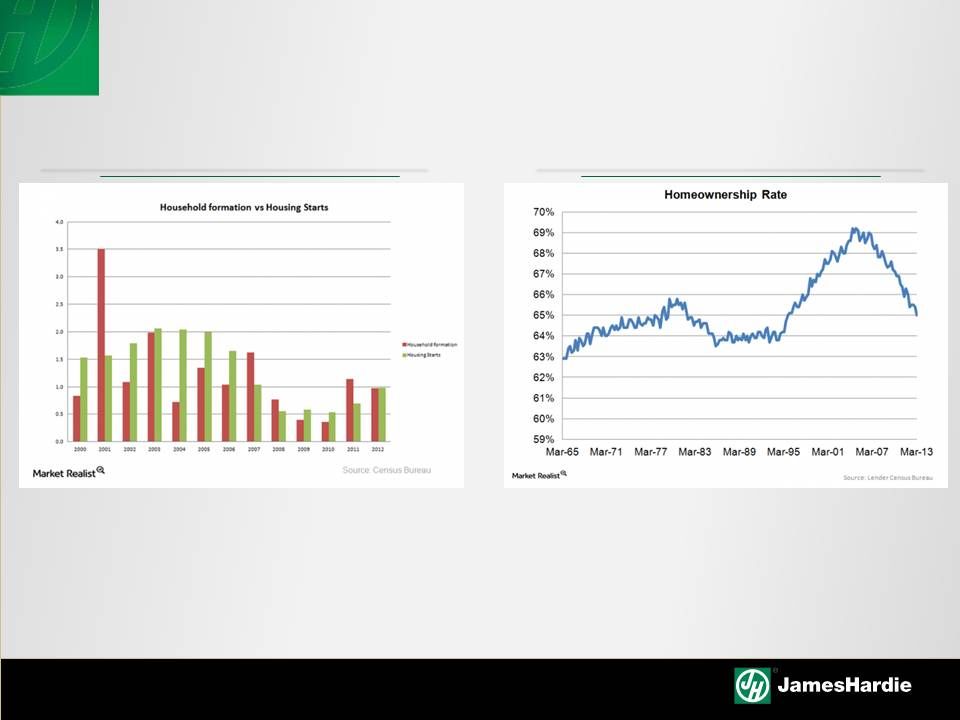 •
Low household formation numbers
over the past five years will drive
homebuilder demand going forward
•
First-time homebuyers in a difficult
position –
student debt, job market, etc.
•
Tougher credit qualification requirements
Formations vs. Starts
Homeownership Rate
UNDERLYING DEMAND FOR NEW HOUSES
LIKELY TO DRIVE NEW CONSTRUCTION STARTS
13 |
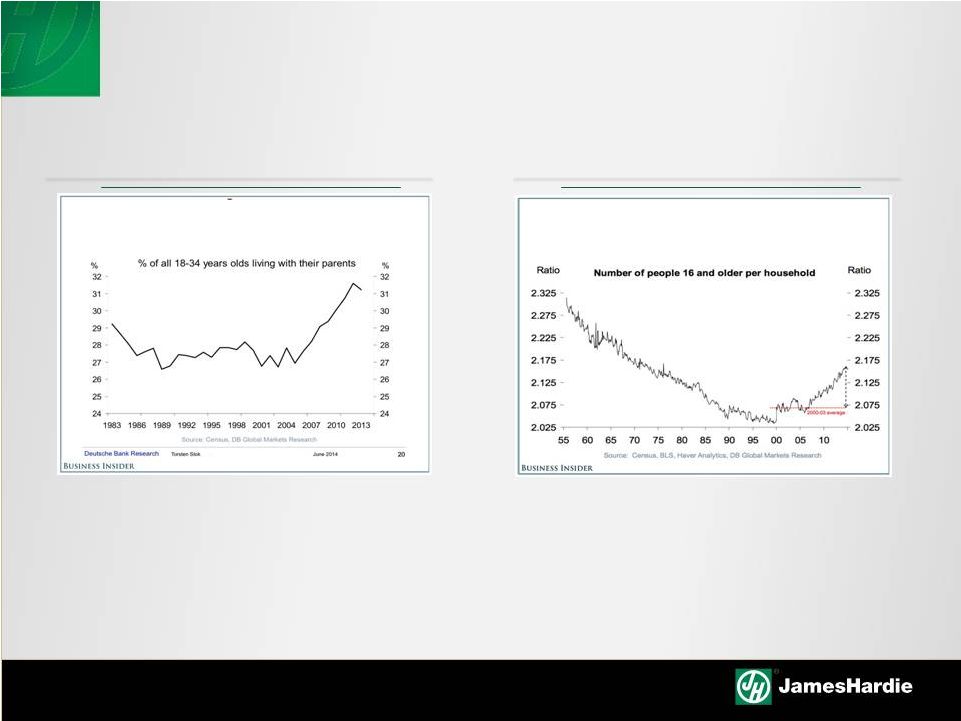  PENT
UP DEMAND FOR HOUSING % of 18-34 year olds living at home
Number of people 16 and older per household
•
Pent-up demand for housing
•
Almost 1/3 of 18-34 year olds now
living with their parents
•
If the number of people per household
returns to the 2000-2003 level it would add
up to more than 4 million new households
Source: Housing Trends: Increase Demand by Jay Taylor, Wyatt Investment Research and Deutsche
Bank Research 14 |
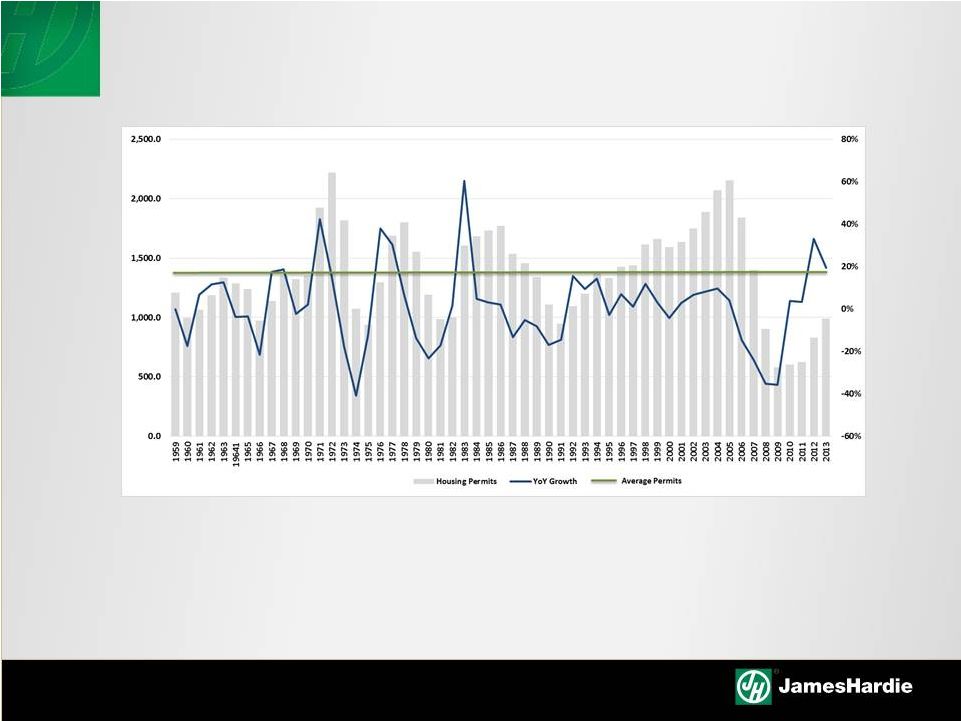 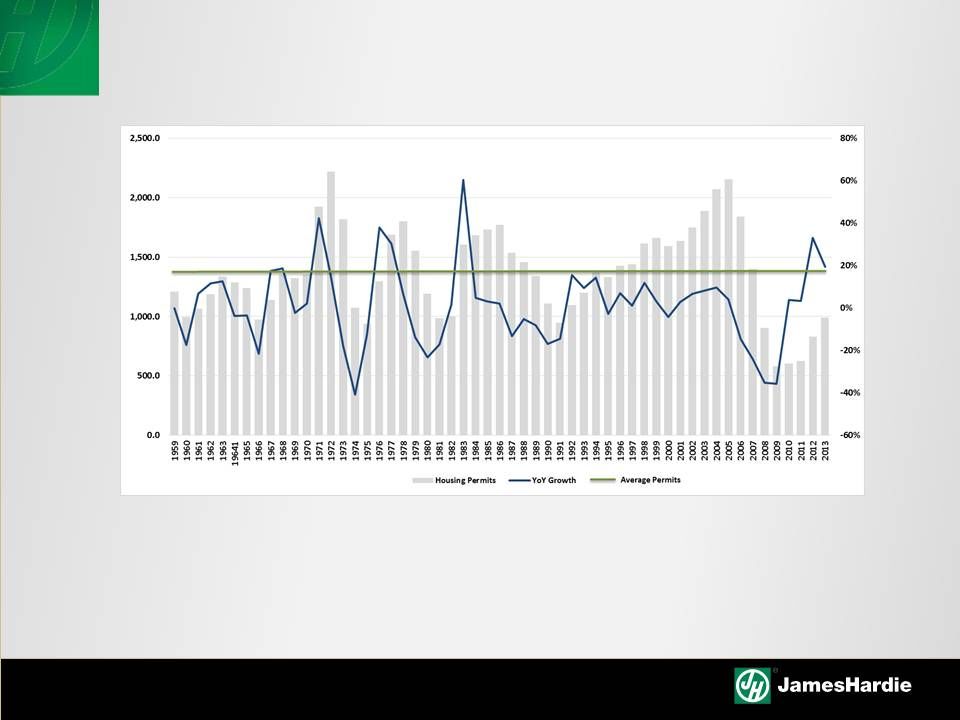 UNDERLYING SUPPLY FOR NEW HOUSES
LIKELY TO DRIVE NEW CONSTRUCTION STARTS
•
Average number of starts since 1959 has been ~1.5M starts per year
•
2013 starts aligned with previous “trough”
years
•
Current starts still has room to expand over the next several years
15 |
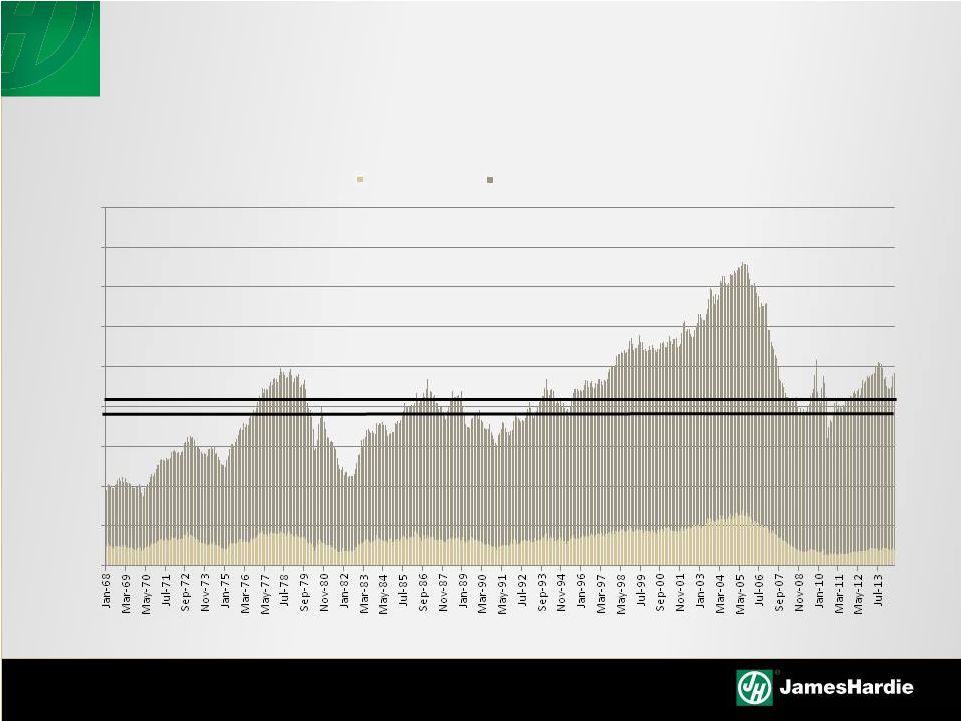 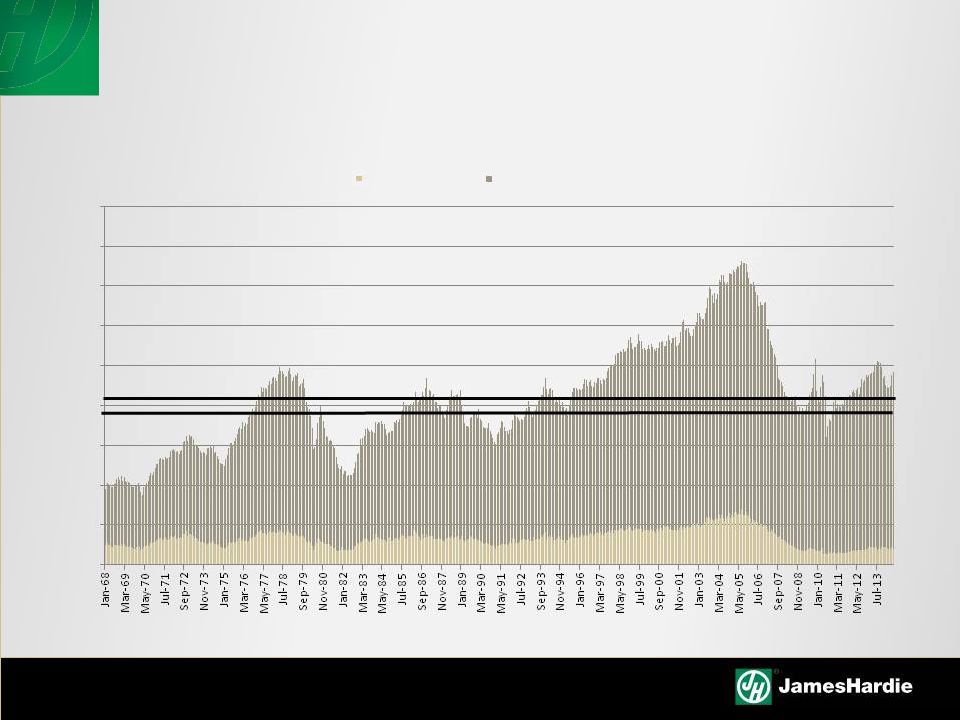 EXISTING HOME SALES REMAIN
ABOVE NORMAL LEVELS
Source: Commerce Department, National
Association of Realtors, Metrostudy Analysis 16
0
1,000
2,000
3,000
4,000
5,000
6,000
7,000
8,000
9,000
SF Home Sales, 1968-April 2014 (SAAR Thousands)
SF New Home Sales
SF Existing Home Sales
45 year average
4.18 million
3.875 million
sans 2002-2006 |
 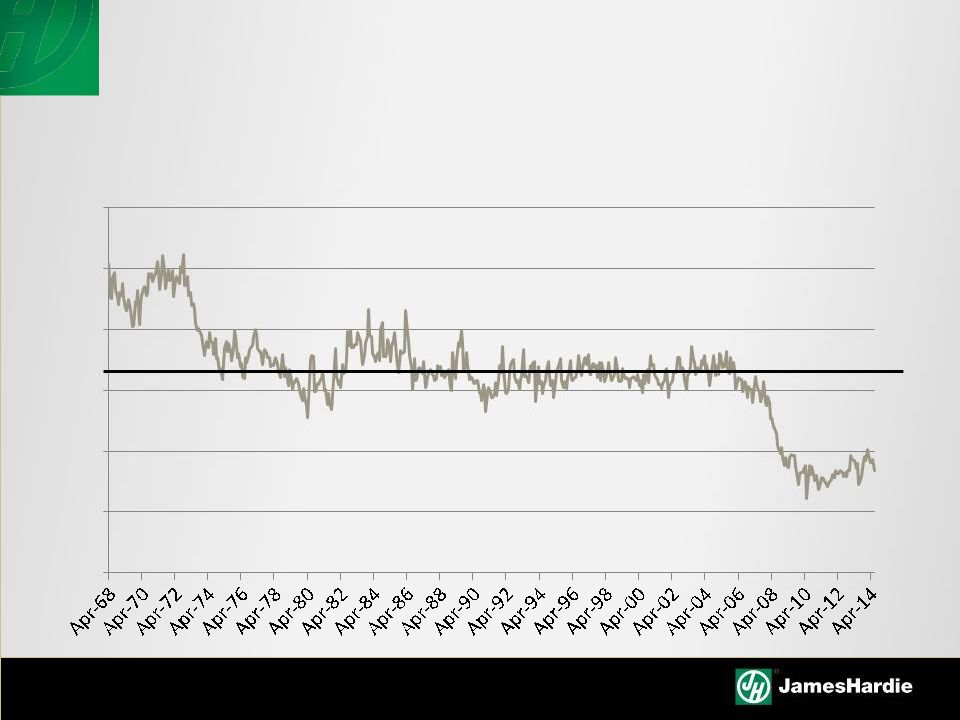 WHILE
HOME SALES ARE AT HIGH LEVELS, NEW HOME SALES HAVE LOST SHARE
Source: Commerce Department, National Association of Realtors, Metrostudy
Analysis 17
0%
5%
10%
15%
20%
25%
30%
45 year average
17% (1/6)
New Home Share of Total SF Home Sales |
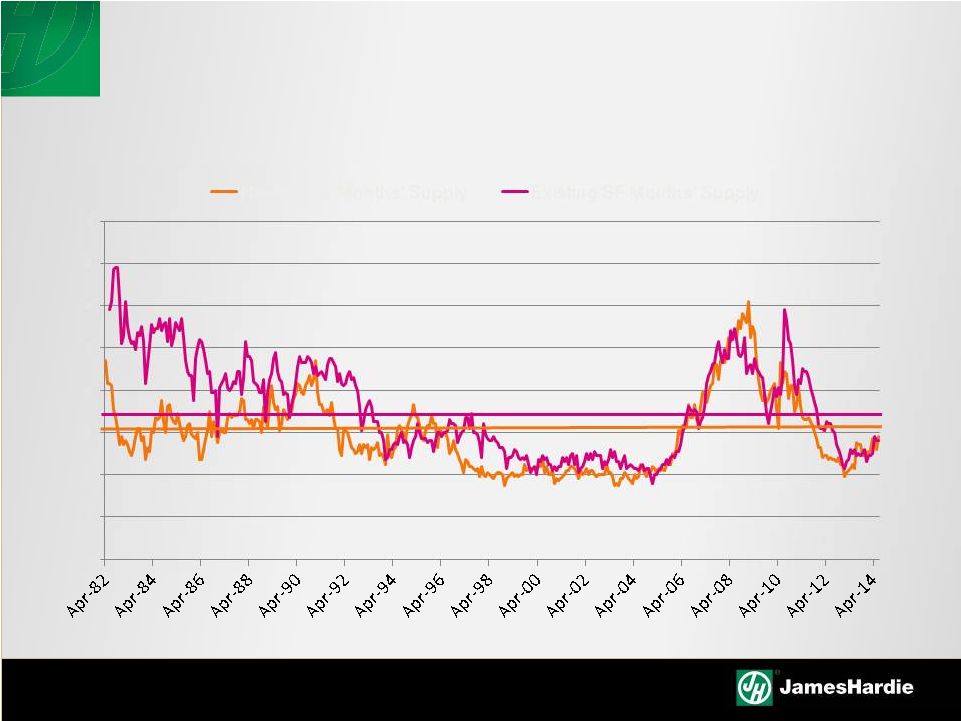 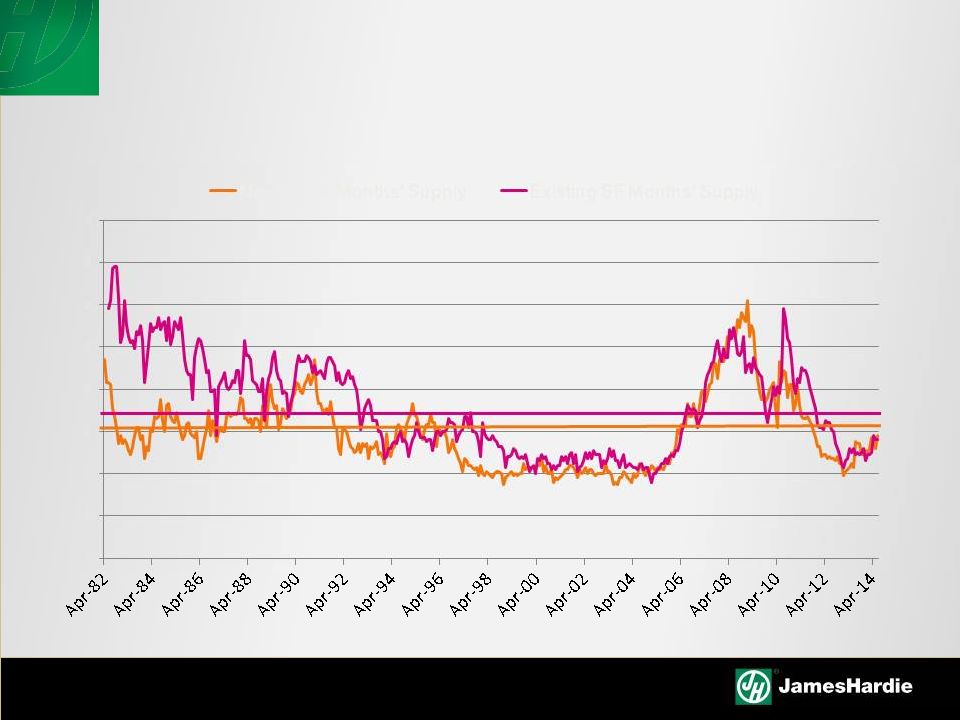 SUPPLIES REMAIN BELOW NORMAL
Source: Commerce Department, National Association of Realtors, Metrostudy
Analysis 18
0.0
2.0
4.0
6.0
8.0
10.0
12.0
14.0
16.0
New and Existing SF Months' Supply, 1982-April 2014
New Home Months' Supply
Existing SF Months' Supply
30 Yr Ave 7.2
50 Yr Ave 6.1 |
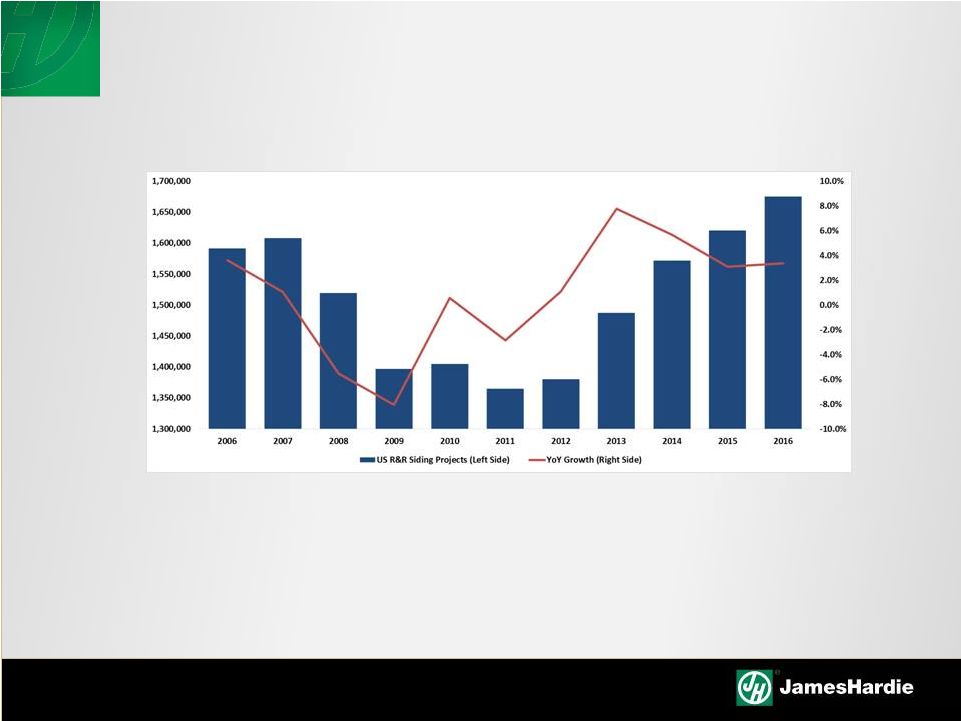  REPAIR
& REMODEL COMPARED TO NEW CONSTRUCTION IS LESS VOLATILE, AND GROWING
Repair & Remodel Market
•
Repair & Remodel market is less volatile and currently as big as
new
construction
•
Year-over-Year growth ranges from -8% to +8%
•
Forecasted to grow 3% in 2015 and 3+% in the medium-term
Sources: James Hardie Internal Management Estimates.
19 |
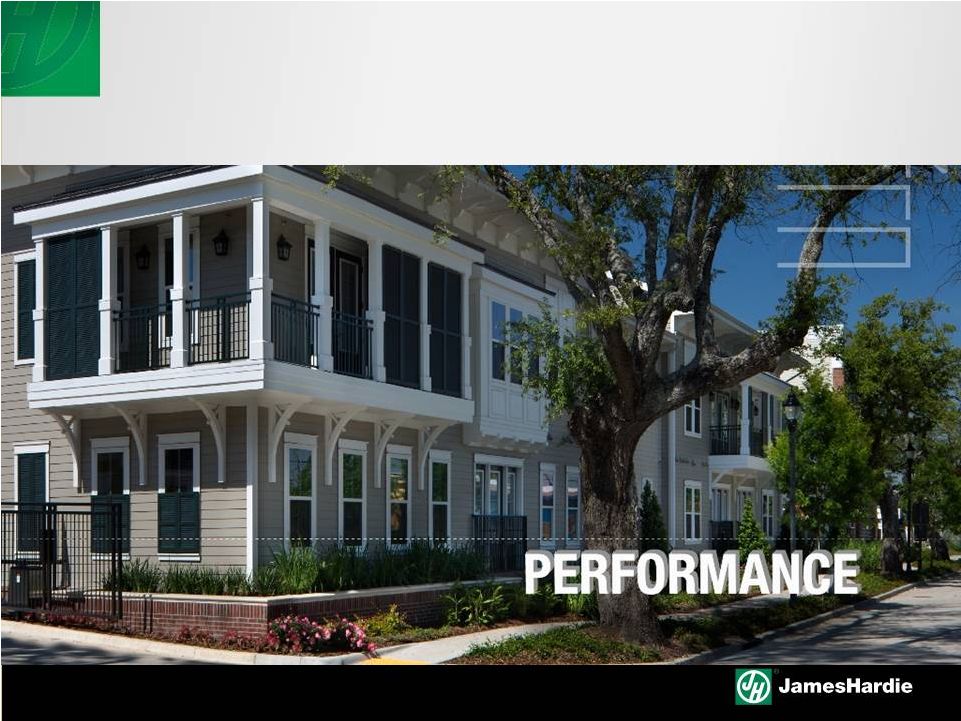 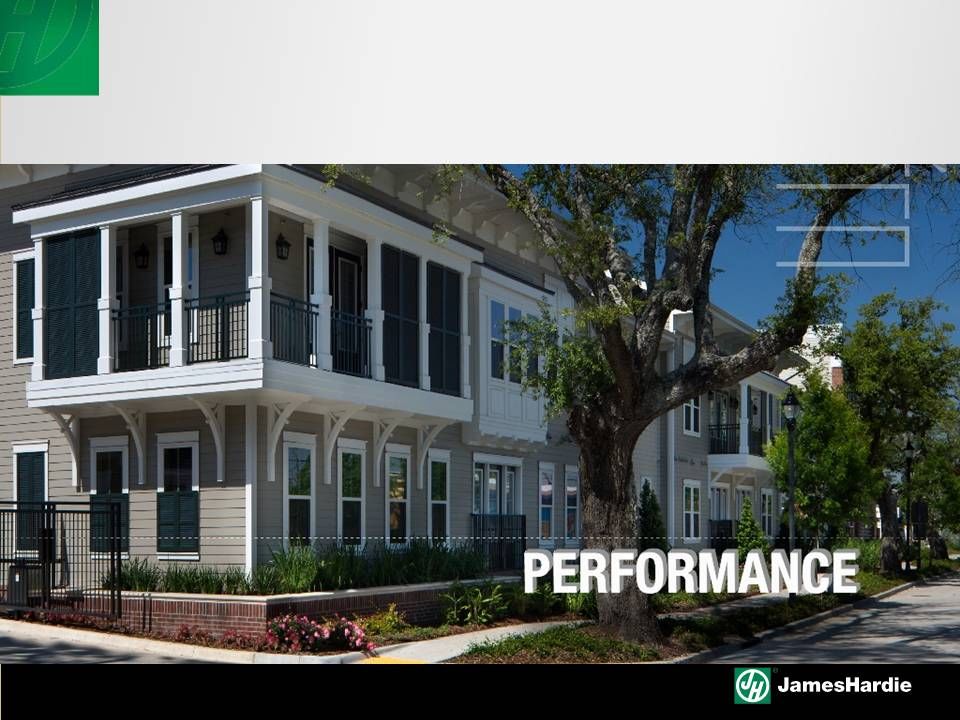 MARKET
OPPORTUNITY 20 |
 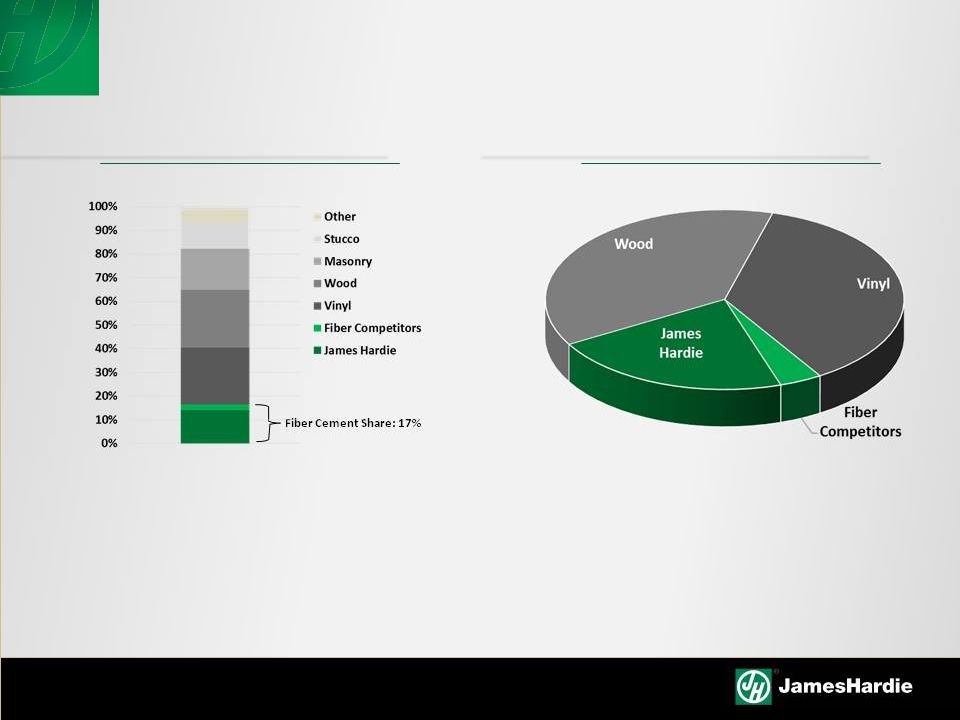 NORTH
AMERICA MARKET OVERVIEW North America Market Share by Product
•
JHX wins ~90% of the fiber cement category, while fiber cement
used in ~17% of the total market
•
Current estimate is wood-look siding (Wood, Vinyl and Fiber
Cement) is 60-65% of total market.
North America Wood-Look Market Size
Source: Internal estimates based on NAHB product usage data adjusted
for regional market intelligence
Source: Internal estimates based on NAHB product usage data adjusted
for regional market intelligence
4.7BSF
Fiber Cement Share 25%
21 |
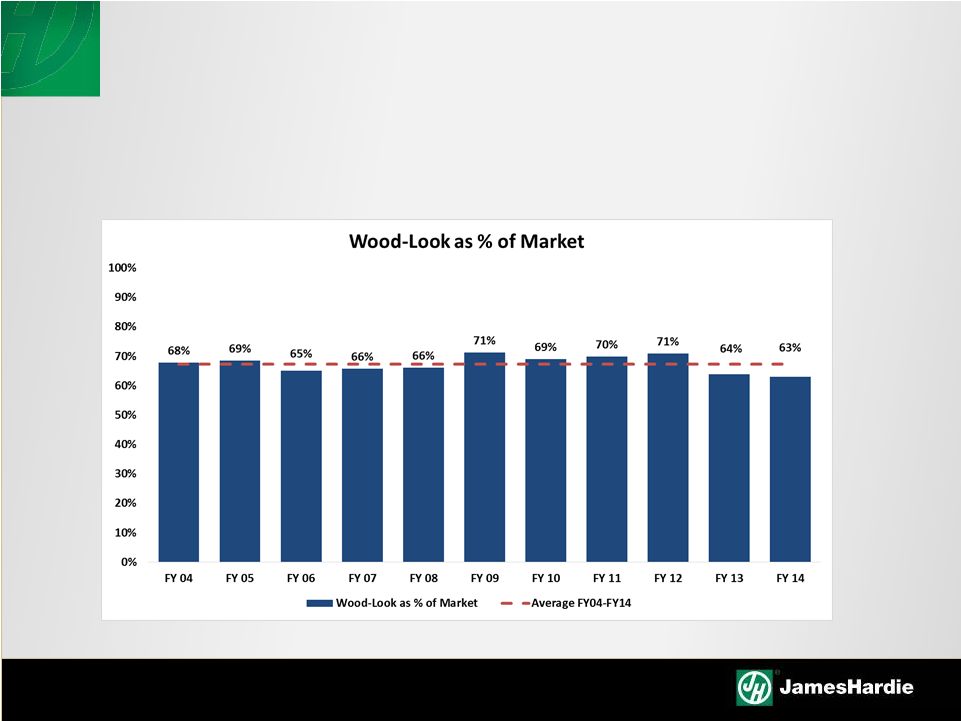 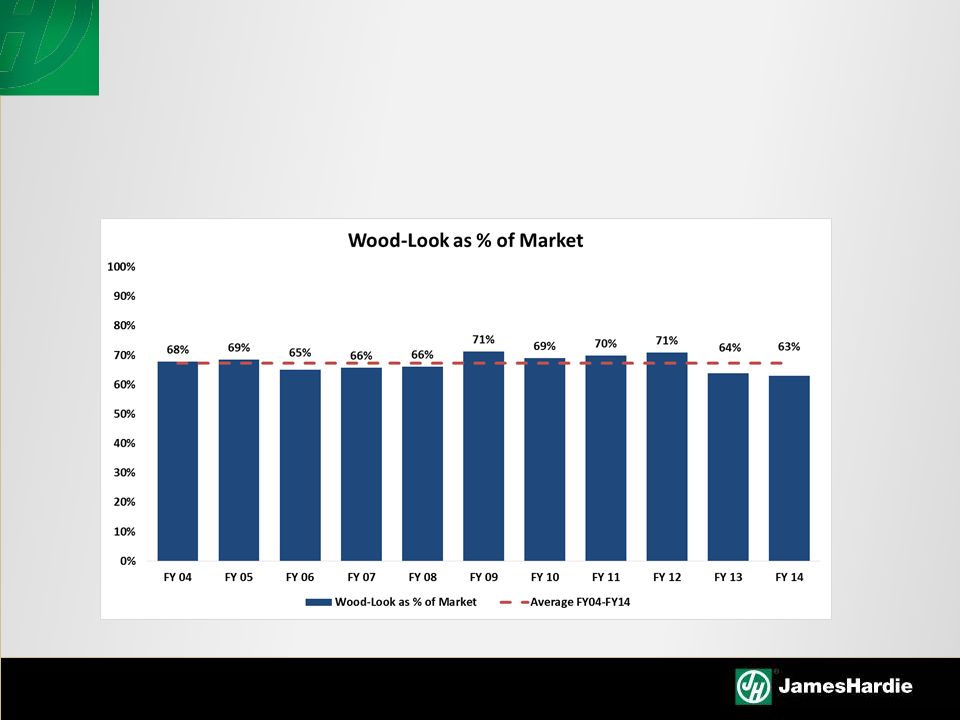 WOOD-LOOK SHARE OF
TOTAL MARKET
Wood-look products continue to maintain ~ 2/3rds of the of the
wall against stone, stucco, and brick
Source: Internal estimates based on NAHB product usage data adjusted for regional
market intelligence 22 |
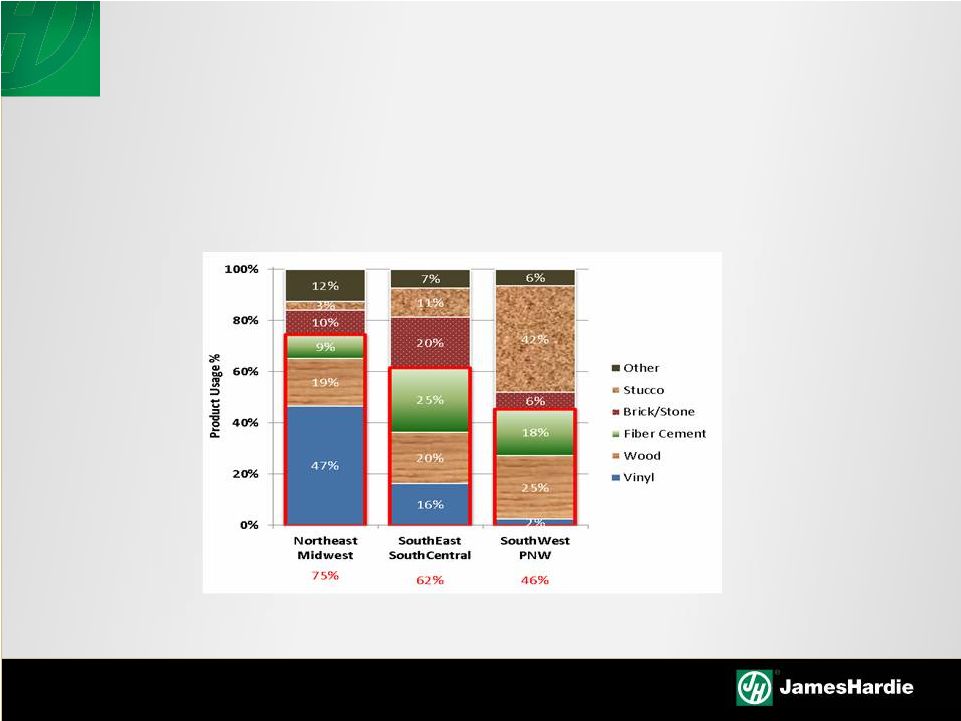  WOOD-LOOK SIDING SHARE
Growth opportunity varies by region, vinyl & wood in the north, wood
and competitive cement in the south and west
Internal
estimates
based
on
NAHB
product
usage
data
adjusted
for
regional
market
intelligence
23 |
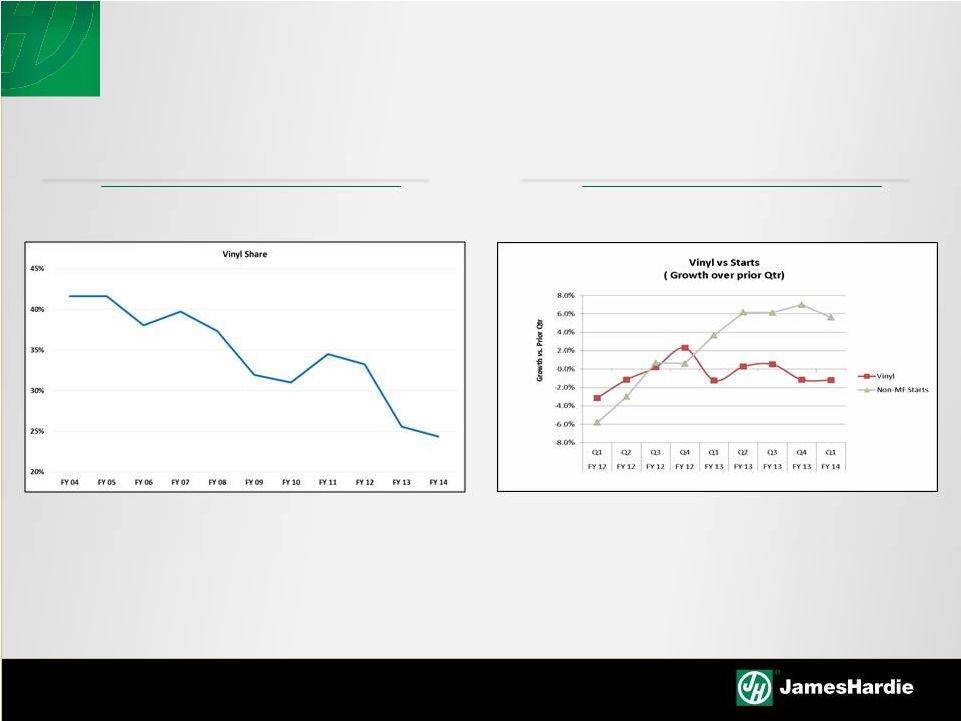 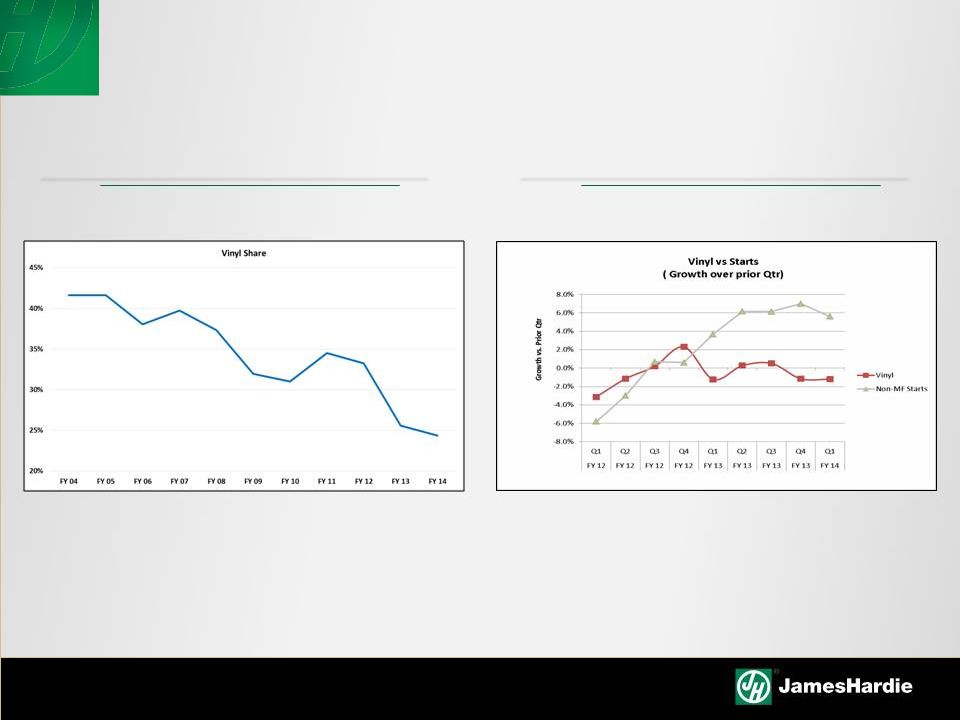 VINYL
CONTINUES TO UNDERPERFORM Vinyl’s Weaker Market Position
Vinyl Under Performing vs. Starts
Source: Internal estimates based on NAHB product usage data adjusted
for regional market intelligence
24 |
 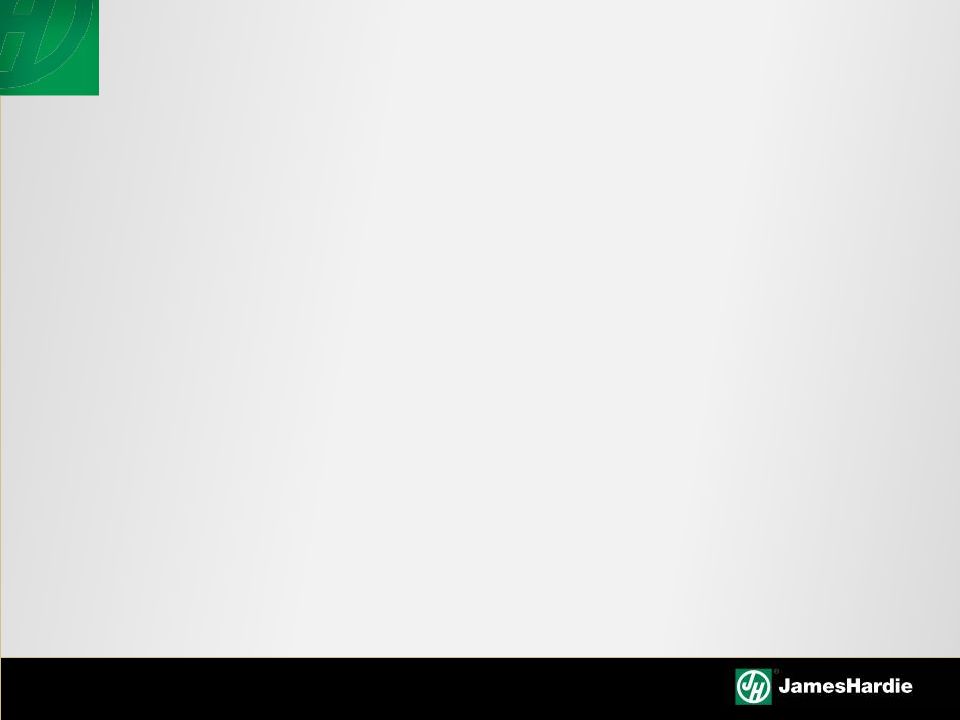 COMPETITIVE FIBER CEMENT
Competitive Fiber Cement competitors appear to be optimizing
their businesses instead of ramping up idle capacity
Nichiha
•
Announced restricted shipping radius to local market
•
Performance concerns in harsh climates; High reject rate
Allura
•
Elementia Corp, parent company of PlyCem and MaxiTile,
acquired from CertainTeed (St. Gobain) in 2014
•
Terre Haute location remains idled
25 |
  •
U.S. economic indicators improving .. Broader economy in recovery
•
Recovering housing market
•
New construction growth below historic levels …
pent up demand and below
normal supplies should support new construction starts heading towards
1.5M
•
Wood look siding is greater than ~2/3 of the cladding opportunity in the US
•
Vinyl share declining as the US housing recovery take place
•
Engineered wood has taken some share in the downturn and presents itself
as a competitive threat in markets susceptible to a wood based product
•
James
Hardie
is
well
positioned
by
segment
to
deliver
on
our
product
leadership strategy driving growth towards 35/90
26
SUMMARY |
  QUESTIONS |
  |